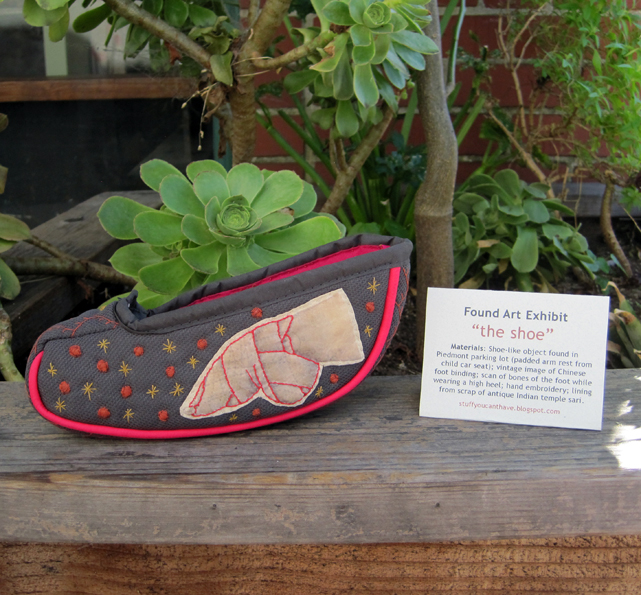 |
| 3 gingko-printed inside-out boxes |
It only takes one "hmmm...." moment to start an obsessive, hands-on maker fest. My most recent bout began with a cup of Yogi Ginger Tea from Trader Joe's. While waiting for the water to boil I looked down at the open box of tea and realized the folks at Yogi had gone to considerable effort to decorate the inside of their box. Curious, I settled in with my cup of ginger tea and took their box apart. From that point, turning the entire box inside out and re-glueing it seemed like an obvious idea.
 |
| Yogi tea box unfolded |
It was the fate of this particular box to become a tiny puppet theater, produced by one of my grandnieces, but I began to wonder about the many other boxes that cycle through my life, ones with blank interiors.
 |
| Inside-out box theater |
I began to take apart boxes that would otherwise have ended up in the garbage, turn them inside-out, re-glue, and decorate the new exterior. The result? A lovely array of gift boxes for future use. Below are boxes sporting experiments with gingko leaf printing.
 |
| Before: Nicotine lozenge box |
 |
| After: gingko-leaf printed inside-out box |
 |
| Before: cookie box |
 |
| After: gingko print box with peekaboo tissue reveal |
The How-To:
Turning boxes inside-out is really easy. The only trick is to start by finding the hidden side seam. Peek inside an empty box and you will spot an overlapping seam at one of the corners.
 |
| Find the hidden seam |
Next, gently pry that seam apart, using your fingers. There will probably be a little paper tearing as you pry one glued section from another but don't worry, marred sections will be hidden when you glue the box back together.
 |
| Pry seam apart |
You will now have an intriguing flat box. First, turn every fold on the box firmly in the opposite direction from its original fold. Re-flatten the box. At this stage you can decorate the blank side of your box any way you wish. This could be a great project for kids using markers or crayons or paint for highly personalized gift boxes for holidays and special occasions. Just the process of seeing how the geometry of box shapes work is fascinating — at least it is to me.
 |
| Unfolded box |
For my first box decorating project I used gingko leaf printing, which simply involves painting a gingko leaf with acrylic paint (copper in this case) and pressing it onto a surface. I usually get two prints out of one painted leaf round, and find that the second, fainter print reveals more leaf detail. You can use each leaf over and over, but try varying sizes for visual interest.
 |
| Gingko leaf printing |
I also splattered the gingko boxes with a little gold paint, using an old tooth brush.
 |
| Gingko-printed boxes with splattered gold |
The final step is to re-glue the boxes inside-out, beginning with that hidden side seam. You have already reversed all of the folds in the box, so the re-glueing process should be easy. When glueing the side seam, overlap the seam so that any marred, torn areas from taking the seam apart are hidden. Press firmly and let dry for a few minutes before glueing the bottom flaps closed. I found that a glue stick worked just fine.
Below is a final (for now) pass at inside-out boxes, using a house fly theme. No particular reason — I just thought it would be visually interesting. Materials here included a felt tip pen, acrylic paint, and some squeeze bottles of puffy 3-D paint. For one of the boxes (see below) I also used a vintage children's printing kit I have to print a quote from Bernie Sanders: "Despair is not an option."
 |
| Inside-out house fly boxes |
 |
| Inside-out fly box with printing and peekaboo tissue |
 |
| Side of box |
The end result of this particular discovery/experiment is that I now have enough unique gift boxes to last a good long while. A more dubious side-effect is that I now have a very difficult time letting any empty box go into the garbage. Here is hoping you enjoy making some inside-out boxes of your own, resulting in a lot more gift giving and a lot less landfill.





















































